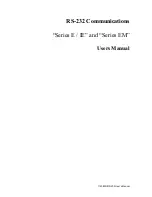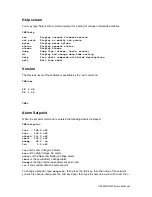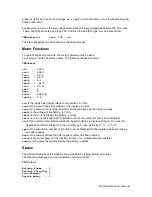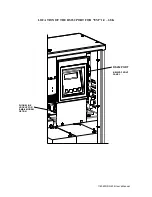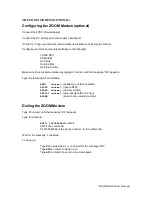
114063D RS-232
User’s Manual
In this example, the inverter is running on utility power, so the
Battery Power
status is 0 (false)
and
Line Present
is 1 (true).
Battery Charging
is 1 (true) because the battery will always
be charging, even when its full. When the battery is full, the in
verter uses ‘float-charging’ to keep
the battery full
– this only consumes a tiny amount of power (in the ‘meter’ example above, it is
shown consuming 6.6W as it float-charges). Finally,
System Ready
is 1 (true). This will always
be the case unless the inverter is rebooting, on battery power, or charging.
Alarms
The alarm status of the machine is available through the “alarms” command.
When the alarm command is typed, the following information is available.
CMD>alarms
Inverter : 0
Charger : 0
Output : 0
Overload : 0
Overload Shutdown: 0
High Ambient : 0
High VAC : 0
Low VAC : 0
Low Battery : 0
Near Low Battery : 0
Utility : 0
Load Reduction : 0
Runtime : 0
Circuit Breaker : 0
Overtemp : 0
The format is binary. A “1” indicates that the alarm is present (asserted); a “0” indicates that no
alarm is present (unasserted).
The
Inverter
alarm indicates
a problem in the inverter’s internal circuitry.
The
Charger
alarm indicates a problem in the charging circuitry that charges the battery.
The
Output
alarm indicates an issue with the output, such as a short circuit.
The
Overload
alarm indicates too much load (above the rating of the inverter) on the output.
The
Overload
Shutdown
alarm indicates that the load is so high (above the rating of the
inverter) that the inverter has shutdown to protect itself.
The
High Ambient
alarm indicates excessively high temperature inside the inverter cabinet.
The
High VAC
alarm indicates an excessively high input voltage (utility) to the inverter.
The
Low VAC
alarm indicates an excessively low input voltage (utility) to the inverter.
The
Low Battery
alarm indicates that the battery charge has almost been depleted.
The
Near Low Battery
alarm indicates that the inverter is approaching low battery.
The
Utility
alarm is 0 if the input voltage to the inverter is good, or 1 if it is not (indicating that
the inverter is currently running the output from the battery).
The
Load Reduction
alarm indicates a reduction in the load below a preprogrammed
threshold (which may happen if a load device goes offline, such as a lamp out). This feature is
turned off by default.
The
Runtime
alarm indicates a self-test has failed (perhaps due to the age of the battery).
The
Circuit Breaker
alarm indicates that a circuit breaker has tripped. This feature only
works when the right circuit breaker option is purchased.
The
Overtemp
alarm indicates that the internal circuitry of the inverter has reached an excessive
temperature.

